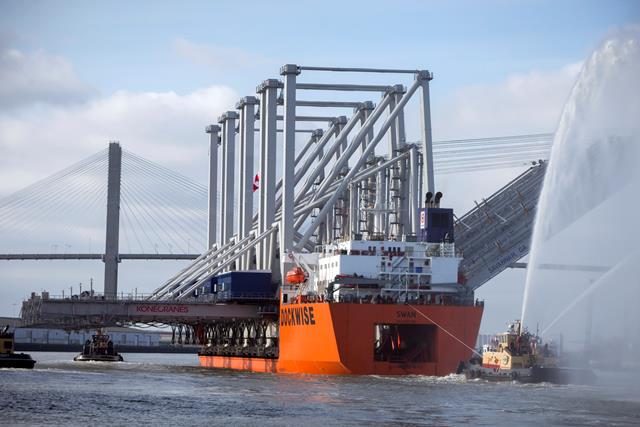Shipping and Logistics

New Cranes Give Georgia Ports a Lift
Written by Sandy Williams
December 19, 2017
The Georgia Port Authority is expanding the Port of Savannah to handle increased cargo demand.
“A strong Southeast U.S. economy, on-terminal expansion, and investment by private logistics firms throughout the region have resulted in phenomenal growth for Georgia,” said Executive Director Griff Lynch.
Total tonnage for fiscal year 2017 grew 23 percent to 33,397,357 tons from 30,832,880 tons in 2016.
The Georgia Ports Authority handled 2.8 million tons of cargo in November, an increase of 8.4 percent from a year ago. Breakbulk tonnage, which includes steel, lumber and autos, increased 25 percent to 248,600 tons last month.
Iron and steel volume and lumber volume both increased by 50 percent at the Port of Savannah last month as demand increased for construction and manufacturing.
Bulk cargo, which includes loose items like iron ore and coal, jumped 37 percent to 170,700 tons at GPA docks.
Container volume reached an all-time high in October. To accommodate increased containers from Neo-Panamax vessels, Savannah is increasing the number of ship-to-shore cranes at its Garden City Terminal.

Four giant cranes sailed into the port in late November and, once commissioned, will bring Savannah’s fleet to 30. Six additional cranes are scheduled to arrive in 2020. When all are operational, the upgrade will allow the port to move nearly 1,300 containers per hour.
The Neo-Panamax cranes are tall enough to lift containers 152 feet above the dock. The booms reach out 192 feet from the dock face. Lift capacity for each crane is 72 tons. With the booms up, the cranes are 412 feet tall. The crane fleet operates nearly 10,000 contiguous feet of dock and nine berth spaces.
Chief Operating Officer Ed McCarthy said the advantage of these new cranes will be enhanced by other ongoing infrastructure improvements at the port, including the Mason Mega Rail Terminal. That project will double the Port of Savannah’s annual rail lift capacity to 1 million container lifts and expand the port’s reach into the Midwest.
“These new cranes will prepare us for the next wave of growth for Georgia and the nation,” McCarthy said. The increase in the crane fleet will help GPA stay ahead of the growth curve. “Nearly two-thirds of the ships serving the Port of Savannah are Neo-Panamax vessels, and we expect the shipping lines to continue their shift toward larger vessels.”
“This investment, totaling $47 million, will help bring in more business and support more jobs, not only for Georgia but for the entire Southeast United States,” added Lynch.

Sandy Williams
Read more from Sandy WilliamsLatest in Shipping and Logistics

Volvo plans to lay off up to 800 workers at US truck plants
The company cited uncertainty about freight rates and demand, regulatory changes and the impact of tariffs.

Trump signs executive order aimed at making US shipbuilding ‘great again’
President Trump on Wednesday signed an executive order meant to breathe new life into American shipbuilding and curb Chinese dominance in the sector.

Great Lakes iron ore trade fell again in March
Recall that shipments also saw a sharp decline in January.

Longshoremen ratify contract with maritime alliance
Nearly 99% of ILA members voted in favor of a new labor deal with the United States Maritime Alliance that covers workers at ports on the Atlantic and Gulf coasts.

Reibus: Flatbed rates up slightly but uncertainty ahead
With construction seasonally soft, the flatbed market remains softer than the other main trailer types.

